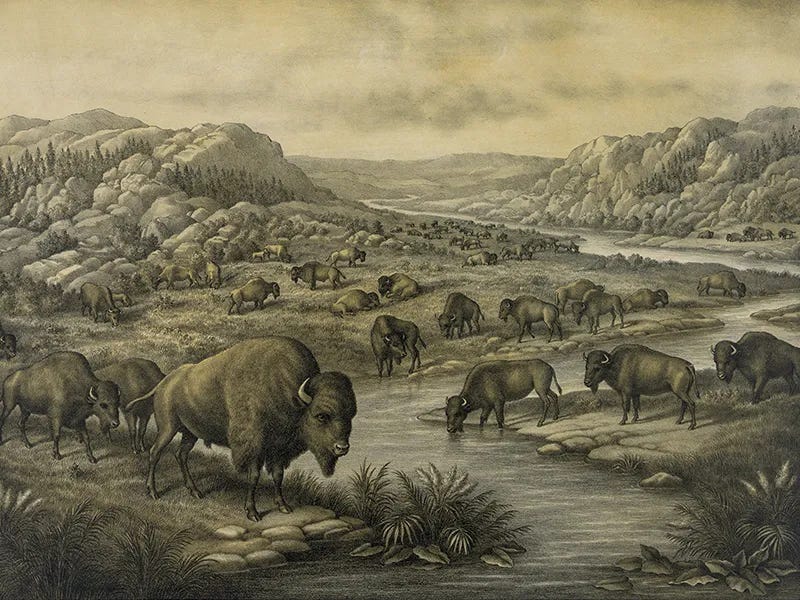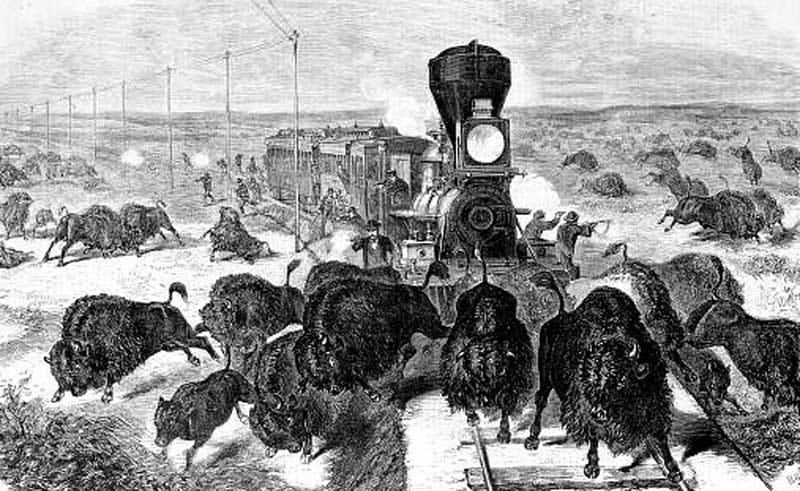Goodbye to the buffalo.
It is the late 1860s.


The Civil War is over, and veterans are readjusting to civilian life.


The transcontinental railroad is under construction, as work crews of Irish immigrants, laying track from the East, race to meet crews of Chinese laborers who lay track from the West.
Millions of buffalo [whose scientific name is the “American Bison”] roam in grasslands stretching from the Appalachians to the Rocky Mountains, and from parts of Canada south into Mexico.
Conflict between Native Americans and white settlers, known as the Indian Wars, rages along the Western Frontier.
It is the convergence of these facts which led to the buffalo slaughter.
These beliefs were the order of the day:
The transcontinental railroad stakes the white man’s claim to the North American continent; and the white man is entitled to exploit all of the continent’s resources. Transporting these resources on the new railroad will make men rich and strengthen the nation.
The limitless supply of buffalo is an untapped source of wealth for Civil War veterans who are good with guns, miss the wartime sense of adventure, and need to cushion the impact of recurring national financial crises.
Native Americans will cease their semi-nomadic hunting lifestyle once their prey, the buffalo, are exterminated. They will then take up farming, become Christian, and will live in villages on land reserved for them. The Indian Wars will end.
But in less than a decade, it became clear to many that those touting the existence of an unlimited supply of buffalo were wrong and the wanton destruction of the buffalo was exacerbating the Indian Wars, not ending them.
Yet, the slaughter would continue until the buffalo neared the brink of extinction.
“On the open prairie…in some places one could walk all day on the dead bodies of the buffalo killed by the hide-hunters, without stepping off them to touch the ground.” Colonel Henry Inman, 1897.
Native American tribes had settled in the rich grasslands of the buffalo thousands of years ago, living at the edge of their herds and migrating with them through broad expanses of the Great Plains.
The buffalo provided everything Native Americans needed to sustain their lives, giving them food, clothing, shelter and spiritual comfort.
But for the white commercial hunter, buffalo were walking sacks of cash.
Sitting Bull [1882]: “White men like to dig in the ground for their food. My people prefer to hunt the buffalo as their fathers did. White men like to stay in one place. My people want to move their tepees here and there to the different hunting grounds.”
Buffalo skins, shipped to factories in the East on the new railroad, were used to make industrial machine belts, rugs, bedspreads, couch covers, and buggy lap robes and many buffalo skins were exported to European markets.
Buffalo tongues, the only part of the buffalo white people then used for meat, were considered a delicacy and were sold to food markets in the East.
After the hunting crew cut out the tongue and skinned the buffalo, the remainder of the carcass was left on the prairie to rot.
‘[W]here there were myriads of buffalo the year before, there were now myriads of carcasses. The air was foul with a sickening stench, and the vast plain which only a short twelve months before teemed with animal life, was a dead, solitary desert.” Lieutenant Colonel Richard Dodge, 1875.
Amateur hunters killed them for sport.
By 1889, only 541 buffalo remained.
Efforts to repopulate the west with buffalo began with the presidency of Theodore Roosevelt, who persuaded Congress to establish several wildlife preserves which were populated with buffalo breeding stock.
Today, about 20,500 purebred American bison live in conservation herds and they are no longer considered an endangered species.
Commercial ranches have another 420,000 bison, which are raised for their meat, hides and skulls; but many of them are not purebred, reflecting the past practice of crossbreeding bison with cattle.
And a few states permit limited buffalo hunting.
So, there has been progress in restoring the buffalo herds.
But the cultural life of the Native Americans of the Great Plains has been irretrievably lost.
That’s what decision-makers of the late 1800s hoped for.
And that’s what they got.
******************************
I’ll see you tomorrow.
— Brenda
Banner image: National Bison Range, Montana. [Ryan Hagerty photo]

























Share this post